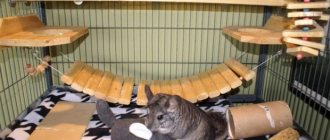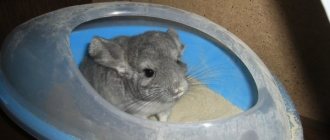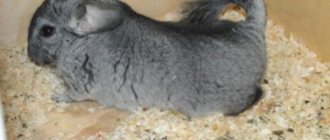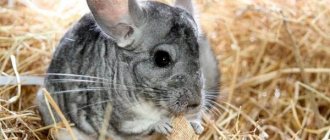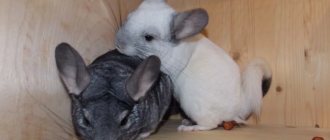- home
- Chinchilla
- Acquisition
03/29/2019 Many happy rodent owners, when buying an animal, do not wonder how old their pet is. However, when caring for a new pet, it is extremely important to determine the age of the chinchilla.
Experts agree that there are several different ways to find out the age of a chinchilla. The main assistants in this matter are the external features and weight of the individual. The ideal time to purchase a pet rodent is considered to be between 2 and 3 months old. At this time, the rodent no longer needs mother's milk and can feed on plant foods on its own. The weight of a two-month-old individual usually does not exceed 300 grams.
How to find out the age of a chinchilla
There are several methods for determining the age of a chinchilla: by weight, behavior, appearance.
But to correctly establish this indicator, experts recommend taking into account all the symptoms and factors together. Important! It is better to take a two-month-old animal into your home. At this age, it is much easier for an animal to adapt to new conditions and its owner. Up to a year, it is quite easy to determine the age of a pet, since at this time a change in the body occurs
An animal is considered an adult at 1 year of age and remains virtually unchanged until reaching the five-year mark. Therefore, it is almost impossible to determine the age in this interval.
Up to a year, it is quite easy to determine the age of a pet, since at this time the body changes. An animal is considered an adult at 1 year of age and remains virtually unchanged until reaching the five-year mark. Therefore, it is almost impossible to determine the age in this interval.
By behavior
Young individuals are more active. Up to a year, animals actively jump and play. With age, their movements become more measured and smooth. In addition, young individuals show curiosity. They are always climbing somewhere. Adult animals prefer to just sit on the perch, and old ones practically do not get off there.
Did you know? South American Indians hunted chinchillas not so much for their good fur, but for their meat. It was used as a cure for tuberculosis.
By external signs
The appearance of an animal can indicate its age.
To find out how old a furry pet is, look at the following parameters:
- The structure of the muzzle. Juveniles up to six months old have a rounder and shorter neck, ears and muzzle than adults. With age, the parietal region elongates and the muzzle lengthens. At the same time, the distance between the eyes also changes over time.
- Features of the feet. Young puppies have smooth, pink feet, without scuffs or calluses. If the skin on the heels has become rough and the color has become yellowish-brown, then this is an adult animal. By the age of five, calluses become pronounced, and by the age of seven, the skin becomes rough. If they are not properly maintained, calluses may appear at a young age.
- Condition and color of teeth. A milk-fed baby's teeth are white. As soon as the puppy begins to eat plant foods, they turn yellow and even take on an orange tint. That is, the darker the teeth, the older the chinchilla.
- Tail. Young individuals have coarser hair at the tip of the tail. Up to a year, the tail is small and less fluffy. Pubescence occurs at 6–8 months.
Another distinctive feature is the genitals. At the age of 4–5 months, secondary sexual characteristics can be detected in males. And at 7–8 months it is no longer possible to confuse a female with a male.
By weight
The first sign by which the age of an animal is determined is weight.
Find out how long chinchillas live on average.
Of course, each animal has its own mass and can be quite plump, but the average standards are as follows:
| Age, month | Weight, g |
| 0–1,0 | 50–100 |
| 1–1,5 | 100–215 |
| 1,5–2,0 | 215–250 |
| 2,0–3,0 | 250–330 |
| 3,0–4,0 | 330–390 |
| 4,0–5,0 | 390–430 |
| 5,0–6,0 | 430–480 |
| 7,0–9,0 | 490–510 |
| 12,0 | 600–700 |
Such parameters do not apply to all chinchillas, because the offspring of small parents may weigh 400–500 g at one year of age. In addition, the animal will develop poorly and gain weight if it is poorly maintained, lacks maternal milk, or is weaned early from its parents. Such an animal, even an adult, will be light in weight. Domestic rodents tend to be larger.
What to do if you are not sure about the correct gender of chinchillas?
If, after observing the behavior of the animal and examining its genitals, there are still doubts about the sex of the animal, then the best solution would be to compare several animals at the same time.
Consultation with a seller at a pet store or breeder
When buying a chinchilla in a pet store, of course, you can consult the seller about the sex of the animal. But there is no guarantee that the information received will be reliable, since stores often employ people who have virtually no experience in keeping animals, not to mention special education. But there is still a possibility that the seller is experienced in this matter.
When purchasing an animal directly from a breeder, it is also not always possible to obtain reliable information. Many unscrupulous breeders are ready to name the gender desired by the buyer so that only the animal can be purchased.
Consultation with a veterinarian
Experienced veterinarians can determine the gender of a chinchilla with almost 100% accuracy. But, if the doctor has never dealt with such animals, the possibility of an error cannot be ruled out. You should choose a good veterinary clinic and an experienced specialist.
Reproduction
Chinchillas reach sexual maturity at the age of 6-9 months, with females maturing earlier than males. Despite the fact that rodents live in colonies, mating occurs with one permanent partner.
The first rut begins in the spring. The gestation period lasts a little more than 3 months. During this time, the female noticeably gains weight, and just before giving birth, she practically stops moving. 2-3 cubs are born in one litter. The animals are born sighted, they have teeth and are covered with fur. The female feeds the babies with milk for up to two months, but already on the 2-3rd day they begin to try plant foods.
Females give birth 2-3 times a year. Re-coating by the male occurs almost immediately after birth. Despite the ability of chinchillas to produce offspring several times per season, reproduction of the species does not occur as intensively as in other rodents due to the small number of litters.
Watch this video on YouTube
Chinchilla nutrition
The first thing a chinchilla owner should remember regarding nutrition is that deviation from the recommendations is unacceptable.
Chinchillas should eat specialized granulated food, to which additional complementary foods containing vitamins and treats are added to make the chinchilla more willing to eat.
Complementary foods are usually mixed into the main granulate, no more than 1/4 of the total mass. Additional recommendations for the ratio of granules and complementary foods depend on specific manufacturers.
You can also add treats to your chinchilla’s diet, which can be easily purchased at pet stores and pharmacies, for example:
- dried apples;
- dried pears;
- dried rose hips;
- hibiscus;
- dried cornflower buds;
- dandelion root;
- dried carrots.
A chinchilla's daily diet should also include hay. It is not advisable to prepare it yourself; it is better to purchase it at a pet store. The hay should be aromatic, green and unpressed. You can also take hay with additives, for example, rosehip flowers or nettles.
Chinchillas cannot be given fresh food; they do not eat “from the table”.
You should also not add seeds, nuts, raisins (an exception is made for females in labor), meat, fish and dairy products to the diet.
Everything a chinchilla needs for health is contained in feed and hay; food that is unusual and unnatural for their gastrointestinal tract can cause constipation, diarrhea and bloating.
Determining the age of a chinchilla
There are several ways to determine how many years or months an animal has already lived.
By weighing
By weighing the animal, you can determine its approximate age using the table below.
| Age in months | 1 | 2 | 3 | 4 | 5 | 7 | 8 | 9 | 10 | 11 | 12 | |
| Weight in grams | 50 | 100-110 | 140-160 | 210-230 | 230-250 | 320-330 | 380-390 | 430-440 | 465-485 | 490-500 | 520-535 | 600-620 |
Of course, the indicated values are approximate, since the animal’s body weight depends not only on its age, but also on feeding and living conditions in general. One thing can be said for sure - if an animal weighs more than 1 kg, it is definitely older than one and a half years.
Visual inspection
Determining the approximate age of an animal is also possible “by eye”.
Young animals are active and restless. They are interested in everything they see around them and try to study every object they discover. Older chinchillas are calm and measured; they usually do not even show interest in new objects.
As for the examination, you can determine the age of the animal:
- by body size - the larger the animal, the older it is;
- along the length of the neck and muzzle - up to six months of age, both the muzzle and the neck of a chinchilla are short, in an animal older than 6 months they are elongated;
- by the shade of the teeth - babies fed on mother's milk have snow-white teeth, but as soon as the animal switches to roughage, its teeth begin to turn red (the richer the orange pigment on the enamel, the older the animal);
- on the paws, or rather, feet.
Paw inspection
Young animals have soft and pink feet. In adult animals, the skin on the feet gradually becomes rougher, and calluses form. The more there are, the older the animal being examined.
Weighing frequency
Weighing chinchillas doesn't do much unless it's done regularly. One weight here and another weight do nothing to establish a normal weight for a chinchilla. Weighing should be done on a regular schedule, such as weekly or monthly. The more often you weigh yourself, the easier it is to see your weight loss. Chinchillas should be weighed weekly, but if this is not possible, monthly is fine. Make sure the weights are taken at the same time of day each time. Regardless of whether monthly or weekly weights are taken, they should be done on the same day of the week and at the same time of day to ensure that eating, drinking or physical functions do not cause an obvious swing to one side or the other . An adult chinchilla can lose up to 10 grams in just a few seconds if they have just emptied their bladder. Similar,
how to determine the age of a chinchillaThere are some circumstances when a chinchilla should be weighed more often. These include sick chinchillas and newborns. Sick chinchillas should be weighed daily to determine whether the chinchilla is getting better or worse. Kits should be weighed daily. Weighing yourself is a good way to know if your mother's milk has arrived. If this does not happen, the sets will lose weight. Another reason to weigh the kits is to see if any of the kits are being abused or allowed to be eaten by their siblings. Kits should be weighed up to 1 week after weaning. This will help the owner know if he has problems eating or drinking on his own.
In wild nature
Chinchillas live in the foothills of areas of Peru, Chile, Bolivia and Argentina. In the wild, they live on average no longer than 10 years. Owls and other birds of prey, as well as foxes and feral cats, are the main threats to chinchillas and often prevent them from reaching their biological potential.
Another major threat to the life and population of these rodents is human activity. Chinchilla fur is of great value for clothing, and although hunting for them is illegal, it still continues. In addition, human impact on the natural habitat of animals is reducing their habitats and the population as a whole.
How to weigh
Using a bowl like the one pictured above can help.
keep a young or adult chinchilla on the scale long enough,
to weigh them. First, gather all the equipment before you take your chinchilla out of the cage. The scale should rest on a stable surface such as a countertop or table. As mentioned earlier, if the scale does not have a weighing container, a bowl, box or small cage will do. Turn on the scale, make sure it is set to grams, and then place the container on it. Most scales have a container feature. This allows the user to compensate for the weight of the container. Simply press the tare button while the container is on the scale. Once the scale reads zero with a container on it, place the chinchilla in the container, find the reading and write it down. Some chinchillas actually sit on scales without a container. If the chinchilla wants to sit on the scale, the container and container function are not needed. A small treat given to a chinchilla can keep the chinchilla busy and still be enough to weigh him down. If the scale does not have a container function, weigh the container, then place the chinchilla in it and weigh them together. Subtract the weight of the container from the total weight. The result is the chinchilla's weight.
Weighing frequency
Weighing chinchillas doesn't do much unless it's done regularly. One weight here and another weight do nothing to establish a normal weight for a chinchilla. Weighing should be done on a regular schedule, such as weekly or monthly. The more often you weigh yourself, the easier it is to see your weight loss. Chinchillas should be weighed weekly, but if this is not possible, monthly is fine. Make sure the weights are taken at the same time of day each time. Regardless of whether monthly or weekly weights are taken, they should be done on the same day of the week and at the same time of day to ensure that eating, drinking or physical functions do not cause an obvious swing to one side or the other . An adult chinchilla can lose up to 10 grams in just a few seconds if they have just emptied their bladder. Similar,
how to determine the age of a chinchilla
There are some circumstances when a chinchilla should be weighed more often. These include sick chinchillas and newborns. Sick chinchillas should be weighed daily to determine whether the chinchilla is getting better or worse. Kits should be weighed daily. Weighing yourself is a good way to know if your mother's milk has arrived. If this does not happen, the sets will lose weight. Another reason to weigh the kits is to see if any of the kits are being abused or allowed to be eaten by their siblings. Kits should be weighed up to 1 week after weaning. This will help the owner know if he has problems eating or drinking on his own.
Signs of old age
Senile changes in chinchillas are divided into 2 stages:
- presenile;
- senile.
By the age of 12, chinchillas show signs of old age. The speed of the animal’s movements decreases, hearing and smell deteriorate, and reproductive function fades.
The appearance of the furry pet also changes:
- the surface of the teeth is worn off;
- the coat thins and loses its gloss;
- pigment spots appear on the ears;
- the eyes stop shining.
In old age, atrophy of the skin and muscles is observed, and tumors often appear. Hypofunction of internal organs, slowing down of metabolic processes and weakening of adaptation are observed. In old age, a pet especially needs a healthy diet and special attention from its owners.
Important! If the most comfortable conditions are provided, a chinchilla can live at home for up to 25 years.
Productivity
Initially, the breed was conceived as a skin breed, and meat characteristics came as an additional bonus. However, in practice, breeding chinchilla rabbits pursues both goals - obtaining both meat and skins.
The quality of the fur of the Soviet chinchilla is on average one and a half to two times better than that of ordinary rabbits. For this reason, chinchilla skins are readily purchased by enterprises specializing in the production of fur products.
Moreover, often the fur does not even have to be tinted, as is the case with the fur of other breeds of rabbits. The natural color looks solid enough to be used in its original form.
As for meat indicators, the slaughter yield at 120 days of age in rabbits of this breed averages 56-58%.
This is noticeably lower than that of ordinary rabbits (60-62%), but do not forget that meat in this case is not the main product. However, some individuals provide even 63%.
Soviet chinchillas show fairly rapid growth rates in the first two months of life, but then slow down significantly.
Having a birth weight of about 75 grams, on the 60th day they reach an average of 1.8 kg, after another month - 2.5-2.8 kg, on the 120th day - 3.5-3.7 kg. Fully mature rabbits weigh on average about 5 kg. Feed conversion per 1 kg of live weight gain in young animals is 3-4 kg.
The fertility of females is not very high: on average there are about 7-8 rabbits in one litter. Thanks to this moderate indicator, female rabbits can easily feed their offspring.
Lifespan of small rodents
Many people are surprised that the lifespan of chinchillas can be so long. On average, these cute rodents live up to 25 years. But what’s interesting is that the life expectancy of chinchillas at home and in the wild is significantly different.
Sorry, there are no surveys available at this time.
In the wild
In the wild, the lifespan of chinchillas is much longer than at home. It is believed that in their natural habitat these rodents can live to an old age of 35 years. However, their period of sexual activity lasts only up to 20 years of life. After this period, they simply “enjoy” old age, so to speak.
After all, not all animals in the wild survive even to the end of their reproductive period. They die not only from the paws of predators, but also from the hands of poachers. Therefore, experts set their lifespan at an average of 20 years in the wild.
Captive
If treated properly at home by a loving owner, a chinchilla can live up to 25 years. The average age of death for rodents in captivity is considered to be 15 years. In the absence of stress, difficult childbirth, illness, in the caring hands of the owner, the animal can live up to 20 years without knowing troubles. The maximum lifespan of a chinchilla at home was recorded at 28 years. Of course, this is different from their life expectancy in the wild. But these differences are both for the worse and for the better.
It is not surprising that the animal is not so comfortable living at home, where practically nothing resembles its natural habitat. However, this is much better than if he died in freedom before reaching a healthy old age.
Do-it-yourself housing for a chinchilla
Often breeders decide to make a chinchilla cage with their own hands.
If you have a desire to tinker, then here are a few instructions to help you. First, buy the necessary materials for the job. It is better to give preference to wood. The frame will be made of bars, lining, boards and many shelves. Chipboard or plywood are also suitable. To close the holes, you need a metal mesh.
The following tools will be useful:
- hacksaw;
- jigsaw;
- hammer;
- drill and wood bits;
- stationery knife, marker;
- metal scissors;
- ruler.
To begin, prepare a drawing, taking into account the size of your room and the size of the desired pet house. Then start making the base, which needs to be covered with clapboard.
Next, the cage frame is built from the bars.
The bars are attached to the corners of the base using self-tapping screws or nails.
Using a metal mesh, the walls of the cage and its roof are tightened.
To make cleaning easier, we recommend making several doors on different sides.
Then you can install various shelves and place the accessories your animal needs on them.
It is best to cover the back of the cage with a sheet of plywood.
Finally, it is necessary to treat the house with a protective impregnation.
If you show your imagination, you can use old furniture and other available materials. An old cabinet is often used:
- The doors are removed from the furniture and the inside is repurposed for animals. Some of the shelves are cut out to allow animals to move freely.
- You need to cut a hole in the top of the closet and stretch the mesh so that the house is ventilated.
- In place of the cabinet doors, you can make frames from wood and tighten them with a metal mesh.
A do-it-yourself chinchilla display “from scratch” will require a little more time and skill.
So, you will need:
- metal tubes for the frame, or wooden yards;
- corners to connect parts;
- cogs;
- metal mesh;
- door hinges.
Then follow the instructions step by step:
| Step | Description |
| 1. | First you need to prepare drawings, taking into account the minimum acceptable dimensions for a chinchilla cage. |
| 2. | Next, we assemble the frame from pipes and yards, using corners for reliability, and fasten them with screws. |
| 3. | Make (internal) markings, designating areas for the animal’s life, that is, think about a place for sleeping, playing, toilet, bath, etc. |
| 4. | The mesh bottom is attached to the cage frame. For this you need a welding machine. |
| 5. | Connect the frame and walls of the house. |
| 6. | Next you need to install the door, use hinges and a lock. |
| 7. | Attach accessories inside the house. |
A do-it-yourself corner display case for a chinchilla is quite popular, because it can significantly save space in your apartment. To make one, show a little imagination and dexterity, and the result will definitely please you!
Where to place a chinchilla cage
Take seriously the choice of place in the apartment where the cage with the animal will be placed. It is better not to change the location of the cage throughout the animal’s life.
Here are some tips for you:
- the room should be dry and light;
- direct rays of the sun should not enter the cage;
- drafts should not be allowed;
- the air temperature where the animal lives should not exceed +23° C.
- the cage should not be placed next to electrical heating appliances;
- It is not advisable to place the cage on the floor;
- the cage should not be placed next to loud devices (equipment);
- Since chinchillas are very active at night, you should not place the cage in the bedroom. It's better to put it in the living room.
Cleaning a chinchilla's cage or display case
It is not enough to simply make a house, choose a place for it and move your pet into it; you must also not forget about caring for your pet’s home. Once a week you need to do a general cleaning, and at this time the animal should be placed in a carrier. The house can be wiped with a wet cloth and even vacuumed. At the end of cleaning, you need to wipe the cage dry. Disinfection (if necessary) is carried out using specialized products purchased at a pet store.
How to achieve uniform development and growth of your pet?
Chinchillas are herbivores that are quite fastidious about changing their diet. They are quite active and playful, so their diet should be enriched with proteins and carbohydrates. Rodents do not finish old food, and if they don’t like something, the rodent will remain hungry, but will not eat what they don’t like.
List of prohibited products:
1. Pine nuts grains, fried seeds. This food will worsen your digestion. 2. Any prepared food; the chinchilla eats exclusively raw foods. 3. Flour products of any kind. The rodent only approves of crackers made from wheat flour. 4. Chinchilla does not digest rye. 5. Products that have no nutritional value. 6. Monotonous diet. 7. Food from the hosts' table.
If you introduce grains into your diet, they should be of exceptionally high quality. Sometimes you can pamper your beloved pet with dried fruits, rose hips, hawthorn, fresh vegetables and fruits. Chinchillas love apples, carrots, bananas, melon, potatoes, and cabbage. The main part of the diet is hay and slightly dried greens. An abundance of carbohydrates will lead to obesity, so feeding the animal is prohibited.
Animal character
According to reviews of chinchilla owners, the character of these animals can be different - kind and calm, or vice versa - aggressive and quarrelsome. Often these qualities are developed in chinchillas under the influence of educational techniques and attitudes on the part of the owners.
At the same time, all chinchillas also have common character traits - intelligence, cunning, timidity, a desire to defend their territory and adaptation to a permanent place of residence.
In a new place, the chinchilla will experience stress at first, but will gradually begin to get used to it and will soon become completely accustomed to its new environment. At this time, it is important to treat the animal with affection and care so that the adaptation period passes quickly and without complications.
The animal is gradually accustomed to handling hands by giving food from the palms - this can be dried fruits or dried rose hips. Gradually, the chinchilla will get used to the hands and will run to them for a treat, but under no circumstances should you catch it in the cage - this will make it even more frightened.
Tamed chinchilla
A tamed chinchilla no longer hides from its owners, but happily sits in their arms, plays and happily welcomes them home from work.
Article on the topic: Is it worth getting a chinchilla: the pros and cons of a pet in an apartment
Those who have decided to keep a chinchilla at home should know that this is a nocturnal animal - it becomes most active at night, sleeping during the day. Knocks, sounds and noises at night from the animal will be a common occurrence, and it will be difficult to sleep in such conditions.
Chinchillas express all their emotions with certain sounds. They usually “talk” with a kind of cooing or hooting, which can be used to determine their mood.
If a chinchilla makes sounds reminiscent of grasshoppers, it means that it is scared and is going to defend itself. Most often, these sounds are heard when someone wants to pick up a chinchilla against its will.
An alarming state is indicated by sounds similar to a dog barking and a loud cry. In nature, chinchillas bark as a sign when they see something unusual that is fraught with danger. A chinchilla produces a piercing cry when she is hurt, as well as when she is very frightened. If your chinchilla makes sounds of anxiety and pain too often, you should take him to the vet.
Although these animals make a lot of noise, they do not like extraneous and loud sounds - so there is no need to place the chinchilla’s cage near the TV or other constantly running household appliances.
Determining the age of chinchillas by behavior
Young chinchillas are more active than their older counterparts. Up to a year, these animals jump very actively, doing everything as if they were playing, after which their movements become smoother.
Young chinchillas are very curious and active, they almost always climb somewhere and run, while an adult prefers to simply climb onto a shelf and sit there, while old animals sit on the shelves almost without getting off.
So, you have learned several ways to determine the age of a chinchilla. At the same time, determining the exact age is definitely considered impossible, but to find out it at least approximately you need to estimate the age of the chinchilla according to all indicators.
For chinchillas under the age of one year, the approximate age is determined quite easily, since at this time the chinchilla is still undergoing some body changes. From one year old to five years old, the animal’s appearance remains almost unchanged, so in the age range from 1 to 5 years it is almost impossible to determine the age of the animal.
You should always remember that a lot depends on the keeping of the chinchilla, because if it lived in inappropriate conditions, then the animal’s heels may begin to become rough early, or it may be too small or too heavy in weight for its age. In addition, if a chinchilla has a weakened body or is sick, then even at the age of up to a year it will not be active and mobile.
There are a lot of factors that need to be taken into account when determining the age of a chinchilla, however, you should not despair, because despite various genetic characteristics, these animals usually have an average weight and average visual signs and behavior, from which you can determine whether the chinchilla in front of you is young, adult or old.
Features of males and females
Owners who get their first pet are often concerned about the choice between a female and a male - are there any differences in maintenance, who is better tamed, more interesting for observation and communication. But if you choose a chinchilla to be kept alone, gender is not so important. External differences are usually almost invisible - sometimes females are larger than males, but the animals have the same body shape and coat. Note that the cost of a chinchilla does not change depending on gender.
The difference is more noticeable in behavior - girls behave bolder and more active. This occurs due to the dominant position of females in the pack. The female chinchilla is curious, loves to explore space, play, and is “talkative,” so she is usually more interesting to watch. The downside may be possible aggressiveness during the period of estrus, as well as the females’ susceptibility to stress.
The adult female is slightly larger than the male
A boy chinchilla is calmer in behavior, easier to tame, and almost never shows aggression. If the owner of the animal is a child, it is recommended to choose male chinchillas as they are safer and more resistant to stress. The disadvantage of a male can be apathy, silence and little interest in the owner.
How to achieve uniform development and growth of your pet?
Any owner is concerned with the question of what needs to be done and how to ensure that their little animal grows up healthy. To do this, you need to understand a few rules:
- You should handle the animal very carefully, because stressful situations can cause it to shed.
- It is necessary to maintain a suitable temperature (which is 18 degrees Celsius) and not exceed 28 degrees, otherwise the animal may die due to heat stroke.
- You need to feed the rodent once a day, with a tablespoon of chinchilla food. To maintain healthy teeth, you can give him a special mineral supplement, as well as a birch or apple tree twig.
- The cage should be metal, 50 by 50 centimeters in size and located in a cool place without direct sunlight.
- A chinchilla in a cage will need: a drinking bowl with water, wheels or ladders, a house and special sand for bathing.
If you follow these rules, there will be no problems with this rodent.
The animal should have access to: a drinking bowl with fresh water, wheels and ladders for games, a shelter for sleeping, as well as special sand for bathing.
If the conditions of detention are met, there will be no problems with this unpretentious creature.
How to extend the life of a pet?
In order for an animal to live to a ripe old age, a rich life, it needs proper care. Chinchillas are no exception.
They need to create the right “habitat” in the apartment. That is, the place where they will live must be comfortable and fully meet their requirements in life. The cage for the animal should be spacious. The minimum area is 0.5 square meters.
The following devices must be installed in the cage:
- a house in which the animal will hide;
- wooden shelves for teeth points;
- hanging drinking bowl;
- feeder, can be either wall-mounted or floor-mounted;
- mineral and salt stones for sharpening teeth - they can also be a source of minerals and vitamins for animals;
- fill the floor with special wood filler;
- hanging canopy.
The video below clearly shows what should be in a chinchilla's cage, and why all this is needed.
It is also important to monitor the temperature of the room in which the chinchilla’s cage is located. In nature, they are accustomed to cool mountain air. At home, you need to get closer to a similar temperature. Although up to 25 degrees Celsius is considered a suitable temperature, the ideal room temperature will still be about 17 degrees above zero. This temperature is more similar to the highlands of South Africa.
In the wild, chinchillas are accustomed to making their own sand baths. This is how they take care of their hygiene and, accordingly, their health. You cannot deprive them of this procedure at home. Bathing in the sand should be regular and even daily. To do this, you can put a container with sand in the animal’s cage, deep enough so that it can bathe on its own whenever it wants.
Nutrition plays one of the most important roles in the process of healing and increasing the longevity of chinchillas.
There is a list of foods that should be avoided in a rodent's diet.
- Sweet foods, such as grapes. Chinchillas' bodies do not produce insulin, which means they will not be able to cope with blood sugar.
- Fatty nuts have a negative effect on the liver of animals, and this also includes sunflower seeds.
- The stone fruit tree, its branches and fruits contain hydrocyanic acid, which is poisonous to rodents.
- Coniferous tree branches.
- Toxic substances that may be contained in paper products (such as newspapers and wallpaper). They poison the body and lead to diseases of the animal’s gastrointestinal tract.
How much does a chinchilla weigh?
Zoologists conducted research comparing the mass of animals. This made it possible to determine the average optimal weight value depending on the age of the animal. Understanding how much a chinchilla should weigh will help you monitor its health. If the animal begins to rapidly gain extra grams or lose them, this indicates problems and should be consulted by a veterinarian.
Chinchillas should be weighed on a scale with 1 g divisions. Newborns - preferably at least once every 2 days, after a few weeks and until reaching puberty once every 5 days. Adults can be checked once a week if there are no visible unwanted changes.
The weight of puppies from birth ranges from 30 to 50 g.
After the baby dries out for an hour, the mother should feed him for the first time. You should be careful if there are 2 puppies in the litter: you need to make sure that each of them is fed milk.
On the first day of life, a chinchilla may lose several grams; this is normal. In the first weeks she will gain from 1 g per day.
Subsequently, up to 6 months, the weight of individuals increases by several grams per day.
A month before puberty, growth stabilizes, and from this moment on, the chinchilla is able to gain no more than 1 g during the day.
At 7 months the onset of maturation begins. From this time until 10 months, the chinchilla becomes an adult, and in the future its growth will not be so obvious. The body weight of an adult animal is 550-600 g.
Average weight values by day and month are presented in the tables.
| Age, in days | Weight, g |
| 30-50 | |
| 1 | 29-49 |
| 2 | 31-51 |
| 3 | 32-52 |
| 4 | 34-54 |
| 5 | 35-55 |
| 6 | 37-57 |
| 7 | 38-58 |
| 8 | 40-60 |
| 9 | 42-62 |
| 10 | 44-64 |
| 11 | 46-66 |
| 12 | 48-68 |
| 13 | 50-70 |
| 14 | 52-72 |
| 15 | 74-74 |
| 16 | 77-87 |
| 17 | 81-91 |
| 18 | 84-94 |
| 19 | 87-97 |
| 20 | 90-100 |
| 21 | 93-103 |
| 22 | 96-106 |
| 23 | 99-109 |
| 24 | 102-112 |
| 25 | 105-115 |
| 26 | 108-118 |
| 27 | 111-121 |
| 28 | 114-124 |
| 29 | 117-127 |
| 30 | 120-130 |
Once the chinchilla reaches 1 month, you should compare the indicators of how it will gain weight to adulthood by month.
| Age, in months | Chinchilla weight, g |
| 30-50 | |
| 1 | 120-130 |
| 2 | 230-240 |
| 3 | 320-330 |
| 4 | 380-390 |
| 5 | 430-440 |
| 6 | 470-480 |
| 7 | 490-510 |
| 8 | 510-540 |
| 9 | 540-560 |
| 10 | 550-580 |
| 11 | 550-630 |
| 12 | 550-660 |
The normal weight of an adult animal can be 800-1000 g if it is a female that did not grow up alone. But you should carefully monitor how the chinchilla moves, to see if there are any abnormalities in the musculoskeletal system and poor mobility.
If the control revealed a decrease in weight by 10 g, this may indicate stress or the onset of the disease. You should check in what conditions the animal lives and what it eats, and whether it receives enough attention. If there has been a change of scenery, you should let him get used to the new place.
Health problems may be related to teeth and intestines. It is recommended to check the animal for the presence of worms.
Pregnancy may be the reason for weight gain in females. You should expect one puppy if the female has gained up to 100 g, if more than 140, then two or three.
Weight gain can be caused by obesity. This is dangerous because it affects mobility, well-being, general health, the functioning of internal organs, and the reproductive system. You should review your diet, remove fried and flour foods, and reduce the amount of fruit.
To maintain health, you should install a running wheel in the cage.
In childhood, the animal should gain weight evenly: this will mean that it receives everything necessary for the formation and growth of the body. And when the chinchilla turns 1.5 years old, any changes in weight up or down indicate developmental abnormalities. The reasons for weight loss or gain lie in illness, violation of living conditions, and the special physiological state of the female - pregnancy.
Factors influencing the weight of a chinchilla: • Genetic characteristics; • Conditions of detention; • Pet health; • Gender of the animal.
An adult female is larger than a male, and a chinchilla raised in pairs is larger than one raised alone. The length of a one-year-old animal is 22-38 cm, and the size of the tail varies between 8-17 cm.
Breeding chinchillas at home
Do not place a female and a male in the same cage at once; for the first two days, their cages should stand next to each other, and only after this period of time can they be placed together. If they are aggressive, they must again be placed in different cages and kept separately until they get used to each other
It is important that this must be done under the control of the owner, so that the animals do not injure each other.
The male reaches sexual maturity at the age of 8-9 months, and the female at 7-8 months. Please note that early pregnancy can worsen her health, even leading to death. The female's sexual cycle lasts 40-50 days, but during this period of time, estrus lasts only 3-4 days. The female carries the cubs for 105-110 days; experts recommend feeding the pregnant chinchilla with more vitamins during this period than with the usual diet. As a rule, one or two cubs are born, very rarely three. During the gestation period, it is necessary to separate the male from the female into another cage. The ability to reproduce lasts up to fifteen years.
It is quite difficult to find out whether a female is pregnant, but there are several signs by which conception can be determined:
- absence of heat;
- enlargement of the abdomen and a feeling of elasticity upon palpation;
- stable increase in body weight;
- increased appetite;
- presence of a plug in the cage;
- swelling of the nipples (at 7 weeks of pregnancy);
- the female is less active, more affectionate, but sometimes, on the contrary, she can show aggression.
Usually the birth of babies occurs at night or early in the morning. The entire birth process lasts no more than 2.5 hours, but if the baby is large, the birth may be delayed. As a rule, human help is not required, but if you notice that something is going wrong, it is better to call a veterinarian, otherwise the mother may die. Difficult births occur only in young and injured females.
How to behave with a newborn chinchilla?
You cannot take a puppy until the female has given birth to all of them and has matured. Newly born babies already have primary hair all over their body, their eyes are fully open, so they can immediately move independently, and they also have teeth. Basically, the body weight of newborn animals is from 30 to 70 grams. Chinchillas stop gaining body weight at the age of two; the normal weight of an adult reaches from 500 to 900 grams.
The female can only feed two cubs herself, and if three are born, then it is necessary to introduce additional artificial feeding from a pipette filled with milk mixtures.
To ensure that the female produces a large amount of milk, give her 1-2 raisins per day.
Babies can be separated from their mother 2 months after birth.
It may happen that the mother refuses to feed her offspring from the first minutes, so the owner will have to take care of the feeding process. You can feed newborn chinchillas with regular baby formula every 2 hours, including at night.
On the fifth day, slowly introduce complementary foods in the form of crushed grain.
You should not be extremely arrogant if you think that with proper care your pet will not get sick. This is far from true, because all living things can suffer from various ailments. If you have the slightest suspicion that your animal’s condition is worsening, do not delay visiting a specialist, since timely and correct treatment will prolong the life of the “furry member of your family.”
Stages of chinchilla growing up
There is no single formula for the relationship between a chinchilla’s life year and a human’s period. This comparison is not valid due to the biological differences between humans and rodents. The age of a chinchilla by human standards can be determined by comparing the important stages of maturation with those of humans. At the age of one month, the chinchilla begins to erupt new teeth. In children this corresponds to the 6th month of life. The rodent's body reaches sexual maturity at 6–7 months, which means that an animal at this age can be compared to a 16-year-old teenager. The reproductive system of a female chinchilla functions correctly until the age of 12–15 years. In a woman, such changes in the body begin in the period from 40 to 50. The lifespan of chinchillas is 20–25 years, so a pet that has reached its third decade can safely be considered elderly and draw analogies with a 75-year-old person.
Features of males and females
Owners who get their first pet are often concerned about the choice between a female and a male - are there any differences in maintenance, who is better tamed, more interesting for observation and communication. But if you choose a chinchilla to be kept alone, gender is not so important. External differences are usually almost invisible - sometimes females are larger than males, but the animals have the same body shape and coat. Note that the cost of a chinchilla does not change depending on gender.
The difference is more noticeable in behavior - girls behave bolder and more active. This occurs due to the dominant position of females in the pack. The female chinchilla is curious, loves to explore space, play, and is “talkative,” so she is usually more interesting to watch. The downside may be possible aggressiveness during the period of estrus, as well as the females’ susceptibility to stress.
The adult female is slightly larger than the male
A boy chinchilla is calmer in behavior, easier to tame, and almost never shows aggression. If the owner of the animal is a child, it is recommended to choose male chinchillas as they are safer and more resistant to stress. The disadvantage of a male can be apathy, silence and little interest in the owner.


